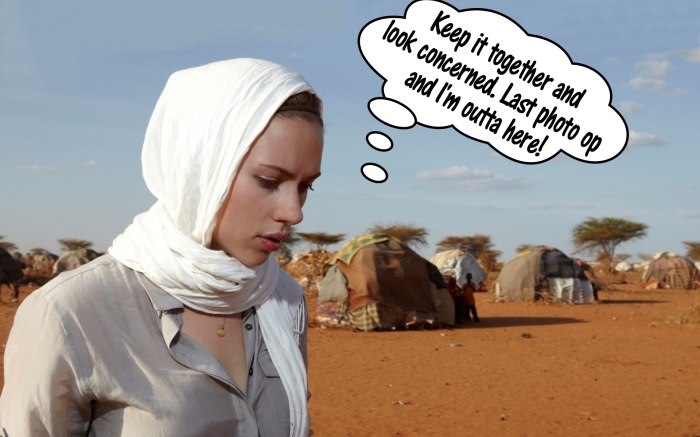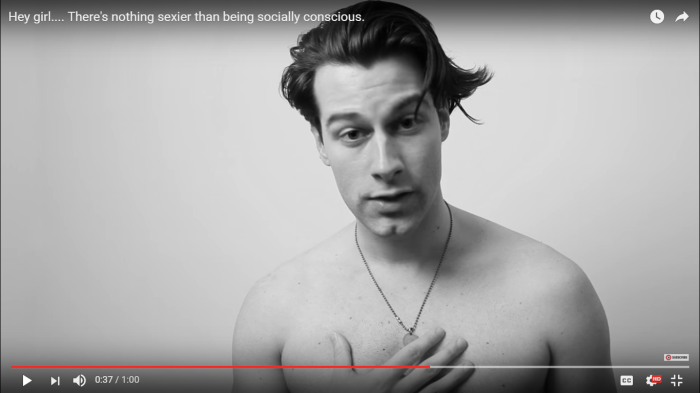It’s Valentine’s day. And conveniently I have stumbled across Global Citizen’s Valentine’s-themed social activism campaign video promoting their aims and values, delivered by several guys, one topless, naturally, along with their boyfriend material-ness and sex appeal. Combined with celebrities campaigning for humanitarian affairs, is this how social activism and humanitarianism are now being promoted? Arguably so.
Far Too Silly, Far Less Serious
The minute-long video is clearly of a light-hearted nature, containing sexual innuendos, muscle-flexing (below), provocative angles and semi-nudity. That said, one may question its target audience and overall intentions.

One of several men states: “Hey girl…There’s nothing sexier than being socially conscious.” The director of this campaign video has arguably made the conscious decision to use muscular, attractive young men in order to advocate for humanitarian affairs and, in this way, overtly seduces the audience into engaging with such issues. Granted, it’s short, it’s sweet, it’s even somewhat amusing, but while a light-hearted innuendo is harmless, one cannot help thinking that this approach is perhaps mocking and sensationalising the more serious matters which are at hand (Chouliarki, 2006 in Cottle, 2009).
“Hey girl… There’s nothing sexier than being socially conscious.”
Development Made Sexy: Aid Campaigns Revised
Development made sexy is arguably a post-modern, post-humanitarian strategy for contemporary humanitarian appeals and campaigns, and re-branding plays a pivotal part.

According to Hanstraa and Cameron (2008), this revised strategy utilises sarcasm and ironic humour, which this video does also, diverting away from previous methods of ‘Poverty Pornography’ and ‘Africa-pessimism’, whereby aid campaigns traditionally used close-up images of starving children (Scott, 2014), or reported on global crises in order to raise awareness about poverty and social injustice within the global South. Thus, there is a shift from exposing or mediating the suffering of distant others, (which has notably evoked several reactions from spectators, including de-sensitisation and indifference, or pity, guilt and moral obligation to suffering, known as ‘compassion fatigue’), to a far more satirical approach (Moeller 1992: 2; Chouliarki, 2006 in Cottle, 2009). Watch how satire has been used in these parody aid campaigns.
Indeed, Development Made Sexy is a considerably creative alternative for raising awareness of humanitarian crises, from food poverty to HIV/AIDS, women’s rights to climate action. It encourages more people to be socially and politically engaged in global affairs, particularly Northern publics who may not have previously been as aware of global crises (Brockington, 2014). Furthermore, the consciousness and self-awareness of re-branding development as ‘sexy’ thereby refers less pessimistically to Africa through ceasing to mediate its suffering, which may reduce ‘compassion fatigue’ among audiences and actually encourage advocacy, through donations and raising further awareness.
However, one can contest this revised approach. As Cameron and Hanstraa (2008) highlight: are the wider, more complex issues at hand, namely the social, economic, contextual and historical factors, which maintain social inequality and injustice, being oversimplified? This approach is therefore effective, but to a considerable extent.
Celebrity Humanitarianism
In recent decades, celebrities have more frequently partnered with NGOs, appearing in their aid campaigns since their popularity and familiarity attracts wider attention. Their intervention often raises NGO profiles, particularly lesser-known ones which otherwise have less presence (Brockington, 2014). Yet, their authenticity and contributions are questionable.
It is highly debated that celebrities have their own selfish agenda: to promote their brand within the public sphere by appearing philanthropic and humanitarian. As Brockington suggests, celebrities may not necessarily have strong relations with the NGO or cause they are campaigning for, which further doubts how well-informed they are to be the face of an aid campaign when informing publics on such matters. Thus, their popularity may simply be undermining the seriousness of such matters (Chouliaraki, 2012).

Actress and Goodwill Ambassador for the UNHCR, Angelia Jolie, is an example of how sex appeal potentially overshadows contributions to humanitarian work. In evidence, Repo and Yjrola’s journal article (2011) notes that the New York Times described Jolie at a UNHCR press conference (left) as:
“Ms. Jolie… her sexy, streaky hair pinned up in a compassionate bun. Black was the colour of her pearls, eyeliner, sleeveless silk dress… ”
Repo, Yjrola and other academics illustrate this awareness of sexualising development, realising the overall limitations and concerns with celebrities, such as Jolie, intervening in humanitarian work, as such involvement is debatably hyper-sexualised and superficial, thereby lacking enough knowledge and sincere concern in effectively contributing towards improving conditions in humanitarian crises. Which brings us to our key questions:
-
Are celebrities, as ‘humanitarian actors’, doing more harm than good? Are they simply performative, lacking ‘real’ knowledge, and capitalising on the suffering of distant others? And as an audience, are we more interested in their campaign, or their image?
-
What are the impacts of gendered stereotypes and sexuality in the development made sexy approach, particularly within this video?
-
Overall, is ‘development made sexy’ a more effective method for aid campaigns than more traditional methods such as ‘poverty pornography’, and in addressing structural factors, too?
Perhaps, Global Citizen, your revised campaigns could have a more long-lasting effect than a minute – or a day.



